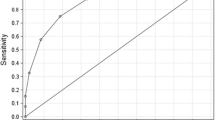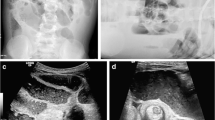Abstract
Background
From the early 1980s onward, US has been considered a possible primary modality to assess patients for ileocolic intussusception. Since 2001, our institution has routinely used US to assess patients for ileocolic intussusception.
Objective
We analyzed 7 years of institutional experience to assess the value of US as a primary diagnostic test for intussusception.
Materials and methods
This study was IRB-approved. From 1 January 2001 through 16 December 2007 814 US examinations for intussusception were performed in children aged 10 years and younger. Clinical records and radiological reports were reviewed for each patient, and cases were classified as true-positive, true-negative, false-positive, or false-negative.
Results
Of the 814 US examinations, 112 (13.8%) were interpreted as positive for intussusception, and of these, 96 were confirmed by enema, 1 was confirmed by surgery, and 15 (13.4%) were false-positive. Of the 814 examinations, 700 (85.9%) were interpreted as negative for intussusception, and of these, 698 (99.7%) were true-negative, and 2 were false-negative. Less than 1% of studies were nondiagnostic. The overall sensitivity of US for detecting intussusception was 97.9% and specificity was 97.8%. The positive predictive value of the test was 86.6% and the negative predictive value was 99.7%.
Conclusion
US is a sensitive and specific test for detecting ileocolic intussusception and should be utilized as a first-line examination for assessment of possible pediatric intussusception.



Similar content being viewed by others
References
Bowerman RA, Silver TM, Jaffe MH (1982) Real-time ultrasound diagnosis of intussusception in children. Radiology 143:527–529
Miller JH, Kemberling CR (1984) Ultrasound scanning of the gastrointestinal tract in children: subject review. Radiology 152:671–677
Pracros JP, Tran-Minh VA, Wright C (1985) Ultrasound in diagnosis of intussusception. Lancet 2:733–734
Swischuk LE, Hayden CK, Boulden T (1985) Intussusception: indications for ultrasonography and an explanation of the doughnut and pseudokidney signs. Pediatr Radiol 15:388–391
Bisset GS 3rd, Kirks DR (1988) Intussusception in infants and children: diagnosis and therapy. Radiology 168:141–145
Bhisitkul DM, Listernick R, Shkolnik A et al (1992) Clinical application of ultrasonography in the diagnosis of intussusception. J Pediatr 121:182–186
Verschelden P, Filiatrault D, Garel L et al (1992) Intussusception in children: reliability of US in diagnosis – a prospective study. Radiology 184:741–744
Weinberger E, Winters W (1992) Intussusception in children: the role of sonography. Radiology 184:601–602
Schmit P, Rohrschneider WK, Christmann D (1999) Intestinal intussusception survey about diagnostic and nonsurgical therapeutic procedures. Pediatr Radiol 29:752–761
Henrikson S, Blane CE, Koujok K et al (2003) The effect of screening sonography on the positive rate of enemas for intussusception. Pediatr Radiol 33:190–193
Eshed I, Gorenstein A, Serour F et al (2004) Intussusception in children: can we rely on screening sonography performed by junior residents? Pediatr Radiol 34:134–137
Justice FA, de Campo M, Liem NT et al (2007) Accuracy of ultrasonography for the diagnosis of intussusception in infants in Vietnam. Pediatr Radiol 37:195–199
Kornecki A, Daneman A, Navarro O et al (2000) Spontaneous reduction of intussusception: clinical spectrum, management and outcome. Pediatr Radiol 30:58–63
Swischuk LE, John SD, Swischuk PN (1994) Spontaneous reduction of intussusception: verification with US. Radiology 192:269–271
Author information
Authors and Affiliations
Corresponding author
Rights and permissions
About this article
Cite this article
Hryhorczuk, A.L., Strouse, P.J. Validation of US as a first-line diagnostic test for assessment of pediatric ileocolic intussusception. Pediatr Radiol 39, 1075–1079 (2009). https://doi.org/10.1007/s00247-009-1353-z
Received:
Revised:
Accepted:
Published:
Issue Date:
DOI: https://doi.org/10.1007/s00247-009-1353-z




